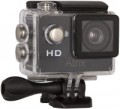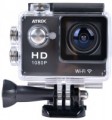HD (720p)
The ability of the camera to record HD video (720p).
The official HD specification provides a resolution of 1280x720. However, in action cameras, there may be resolutions slightly different from this parameter, for example, 1080x720 or 1440x960. Anyway, HD is the most modest of today's high-definition standards, which, nevertheless, provides a fairly clear and detailed image.
Another important parameter given in this paragraph is the frame rate. The higher it is, the smoother the movement in the frame will be, and the details in dynamic scenes will be visible clearly. Technically,
30 fps or even less is enough for video, but
60 fps is considered the perfect value — at this frame rate, motion blur becomes almost imperceptible and at the same time the size of the captured files remains within reasonable limits. However, there are cameras on the market with higher frame rates at HD resolutions —
100 fps,
120 fps,
200 fps and even
240 fps. This speed is usually used for recording slow-motion video, but such a possibility needs to be specified separately.
Full HD (1080p)
The ability of the camera to shoot Full HD (1080p) video.
The standard image size in this standard is 1920x1080. However, in the case of action cameras, this category also includes some other resolutions that are similar in quality, for example, 1440x1080. In general, Full HD provides a very good balance between image quality, the volume of captured files and the processing power requirements for processing them, which makes this standard very popular in modern video equipment — both in cameras and in TV monitors.
Another important parameter given in this paragraph is the frame rate. The higher it is, the smoother the movement in the frame will be, and the details in dynamic scenes will be visible clearly. Technically,
30 fps or even
less is enough, but
60 fps is considered the perfect value — at this frame rate, motion blur becomes almost imperceptible and at the same time the size of the captured files remains within reasonable limits. However, there are cameras on the market with a higher frame rate at FullHD resolutions —
90 fps,
100 fps,
120 fps and even
240 fps. This speed is usually used for shooting slow-motion video, but the possibility of such shooting needs to be specified separately.
Megapixels
The number of megapixels in the action camera sensor, in other words, the resolution of this sensor(1 megapixel is 1 million photosensitive points).
There is an opinion that the higher the resolution, the better the image quality. It is true from the point of view that manufacturers are trying to install high-resolution sensors in advanced cameras. At the same time, there are no strict dependencies here, and from the technical point of view, the number of megapixels determines only the maximum image resolution that can be captured using this sensor. The quality of this picture will depend both on several features of the sensor itself (size, type, special design solutions), and the specs of the camera. So when choosing, you should focus not so much on the resolution of the image sensor, but on the general class of the camera and reviews with examples of footage.
Photo resolution
The maximum resolution at which the action camera can take photos. Specified in pixels horizontally and vertically.
This parameter is directly related to the resolution of the image sensor(see above): the total number of pixels in the photo, usually, corresponds to the number of pixels in the sensor. For example, a photo resolution of 4608x3456 corresponds to a sensor of 15925248 pixels, or approximately 16 megapixels. If the number of pixels in the photo is greater than the claimed resolution of the sensor, then the manufacturer uses software tricks that allow you to improve the photo resolution to a higher one than originally. This reduces the cost of devices but also affects the quality of images.
Theoretically, high-resolution images can provide good detail, but in fact, much depends on the specs of the sensor (primarily physical size) and image processing features.
Capabilities
—
Photo during video. The ability to take photos directly while recording a video — usually using a separate button. Thus, it is convenient to fix the most significant moments of what is happening. Such photos are much better in quality than "freeze frames" from the captured video.
—
Serial photo shoot. This feature allows you to take several pictures at once in a short period (usually it is a fraction of a second). A series of shots increases the chance of capturing a good moment, which can be very important given the specifics of using action cameras.
—
One click recording. The ability to quickly turn on the camera for recording — literally at the touch of a button, by the name. Moreover, such a button works even if the device is turned off. However, the recording inevitably starts with some delay; but often this delay is a fraction of a second.
—
Online streaming. Ability to stream video to popular services like YouTube and social networks (Facebook, Instagram, TikTok, etc.). Usually, the online streaming function is implemented when the action camera is connected to the Internet via a Wi-Fi network, less often via a wired connection. Communication with the World Wide Web can be held directly or through a smartphone or computer. It will require the use of appropriate software.
—
Time lapse. A special mode of operation of the action camera, in which video recording is carried out at a slower frequency is mainly used for filming slow processes. Thus, for example, a long journey or a long sunset can fit into a 3-minute video.
—
Auto-rotate. The function of automatic rotation of the captured photos and videos to the position corresponding to the position of the camera. Without this feature, all footage during playback would be displayed strictly in landscape orientation, and footage shot with the camera upside down or upside down would have to be rotated in a photo or video editor. Usually, at the beginning of video recording, auto-rotation is blocked — so that the position of the frame at any time corresponds to the rotation of the camera itself relative to its original position.
—
Photo panoramas shooting. The ability to use the camera to take panoramic photos. In traditional action cameras (see "Product type"), such shooting is carried out as follows: the camera takes several separate photos, which are then glued into one image. Regarding panoramic and 360-degree models (see ibid.), it is worth noting that not all such models support shooting in panoramic format, so it is advisable to check the availability of this function separately.
—
Key points labels. The ability to add special marks to the footage that indicate key moments. While viewing such videos, you can go directly to the labels — this is easier than manually searching for the right moment. This feature is especially useful when shooting long videos, as well as when numerous individual files. The label, usually, is placed right during the shooting by pressing a special button or by voice command.
—
Night shooting. Special mode for recording in low light conditions. The specific implementation of this function may be different: in some models, the sensitivity of the sensor is increased, in others, shooting in the IR range is used. Accordingly, specific features may vary: not every camera with this function can shoot in complete darkness, and these nuances should be clarified separately.
Connection
—
GPS module. Built-in satellite navigation module that allows you to determine the current coordinates of the device. Options for using data from GPS can be different: geotagging footage, recording travelled routes, determining the speed of movement, or even full-fledged navigation on the map.
—
Wi-Fi module. The Wi-Fi wireless module in action cameras can be used in different formats: in some models, it is responsible for connecting to the Internet, in others it is for communicating with a smartphone or other gadget, in others both options are available at once. Anyway, the main use of this connection is to transfer footage to an external device or to the Internet (including broadcasting in the online streaming format, see “Filming capabilities”). In addition, more specific functions can be provided, for example, using a smartphone as an external viewfinder and remote control. Specific features of the use of Wi-Fi in each case should be clarified separately.
—
Bluetooth. Direct wireless communication technology for exchanging information between two electronic devices. In action cameras, it is most often used to connect remote controls, selfie sticks and smartphones, which can also act as a remote control. Unlike the Wi-Fi module, it consumes battery power more economically, but at the same time, the range of wireless communication is reduced to 10 m
...etres.
— NFC chip. NFC is a wireless communication technology over short distances (up to 10 cm). In action cameras, this technology is mainly used as an auxiliary one, to facilitate connection with a smartphone or other gadget via Wi-Fi or Bluetooth. If such a gadget is also equipped with NFC, just bring the camera to it and confirm the connection — it's easier than fiddling with the settings.
— USB-C. A relatively new type of USB interface that uses a miniature double-sided connector, slightly larger than microUSB. Most often used for similar purposes — as a universal connector through which you can charge the battery and connect the camera to a computer (for copying photos and videos, updating software, etc.). P.). At the same time, USB-C provides a higher data transfer rate than microUSB, supports more power supply, and also has a more convenient plug. Occasionally, there are more specific ways to use this interface — for example, direct connection to a smartphone or tablet that has a USB-C port.
— HDMI output. HDMI is a digital interface specially designed for high-definition video and multi-channel audio. With this output, you can connect the camera to a TV, monitor or other device as an external player and play the footage directly. The convenience of HDMI is that almost all modern video equipment with support for HD standards is equipped with such inputs.
Note that the cameras can be equipped with a smaller version of the connector — miniHDMI or microHDMI; however, finding an adapter cable is usually not a problem, it can even be supplied in the kit.
— Microphone connection. Almost any modern action camera has a built-in microphone that allows you to record sound. However, the quality of its sound is often quite low. Thus, many models can connect an external microphone — you can fix it, for example, on the helmet strap and record the comments of the athlete in the process of movement. Note that different types of connectors can be used for such a connection. As a result, the specific connector type and supported accessories depend on the action camera model, and some devices are only compatible with branded microphones.Speaker
Speaker or speakers installed directly in the camera body. This function is mainly intended to allow you to view footage with sound without connecting headphones or external speakers. However the
built-in speakers do not have decent volume or general sound quality — nevertheless, they allow you to determine what the camera “heard” as a whole, whether sound recording was turned on, whether individual ambient sounds got into the recording, etc.

